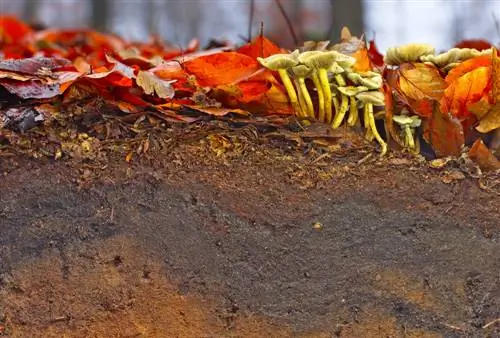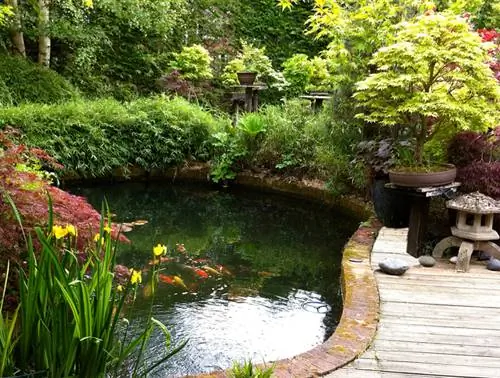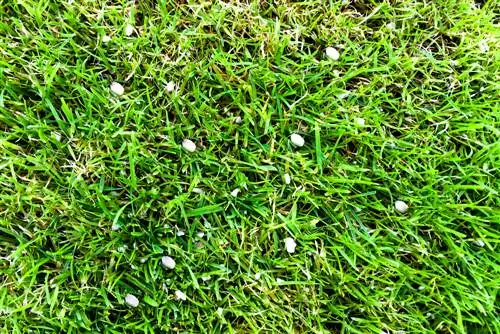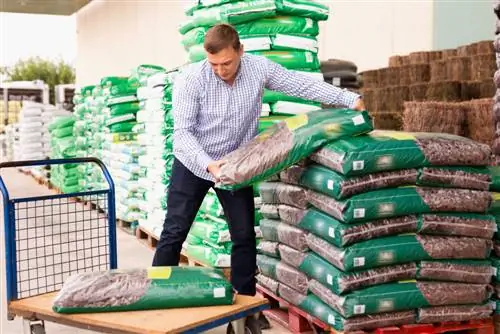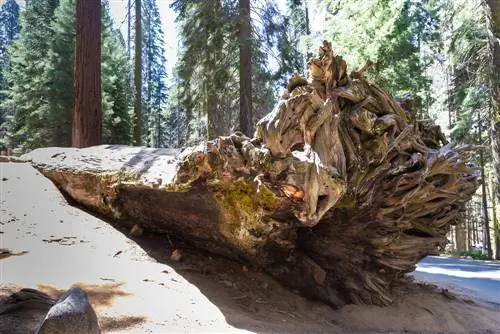- Author admin [email protected].
- Public 2024-01-15 08:07.
- Last modified 2025-06-01 06:02.
The crossword puzzle solution for “containing topsoil with 5 letters” is: earthy. The valuable soil causes more headaches when it comes to its proper use in the garden, under paving slabs or as a base for lawns. However, correct determination of needs and precise conversion are not a closed book. Read this guide on how to calculate the optimal amount. Field-tested instructions explain how to distribute topsoil skillfully and at the right height.
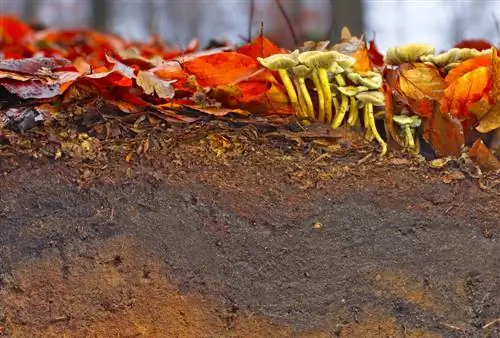
What makes good topsoil?
Topsoil is the fertile upper layer and reaches a depth of 30 cm. The topsoil is made up of nutrients and humus as well as living things. It is an important basis for the plants and animals in the garden.
- Topsoil is the uppermost, fertile soil horizon down to a depth of 20 to 30 cm.
- The protected natural asset is a finite resource made up of humus, nutrients, countless soil organisms and inorganic minerals.
- With a weight of 1.3-1.5 tons per cubic meter, topsoil serves as an important source of life for plants, people and animals.
How much does 1 m³ of topsoil weigh?
If the building owner knows the required volume of topsoil, the question arises as to the weight per cubic meter. Like most building materials, loose topsoil is usually not offered in cubic meters (m³), but in tons (t). The density of the substrate is closely related to the bulk density. Building materials dealers and other suppliers offer topsoil in sifted and finely sifted quality. This results in the actual weight. The following table illustrates the connections:
| Weight per cubic meter | |
|---|---|
| Topsoil sieved | 1500 kg (1.5 t) |
| Topsoil finely screened | 1350 kg (1.35 t) |
| Planting soil 0-15 mm | 1000 kg (1.0 t) |
| Garden soil 0-15 mm | 830 kg (0.8 t) |
Please note when providing this information that topsoil is a natural product. Depending on the origin and composition, the values may vary slightly. For example, some experts rate finely sieved topsoil at 1350 kg/m³, other experts assume 1400 kg/m³. Of course, the differences are not so serious that they affect the weight per cubic meter and thus the budget for your building or garden project. As the table above reveals, significant differences in weight are only noticeable when compared to normal garden soil, industrial or home-made potting soil.

The weight of topsoil can vary depending on its fineness
Tip
Loose consistency is an important quality feature for good topsoil. As a base for lawns or paving slabs, compaction is of course unavoidable. This circumstance increases the quantity required and weight by an average of 10 to 15 percent, which should be taken into account in the calculation.
Calculate the amount of topsoil - this is how it works
For a precise determination of topsoil requirements, all you need is a ruler, paper, pencil and calculator. Measure the length, width and depth of the excavation pit. Write down the measured values in meters. By multiplying all three values together, you calculate the required volume of topsoil in cubic meters (m³). The formula in short version:
Formula: Height x width x depth=amount of topsoil in cubic meters (+ 10-15% due to compaction)
It's easier with a practical requirements calculator, such as those provided by customer-friendly building materials dealers on the Internet (e.g. baustoffe-liefern.de or kieskaufen.at).
Conversion cubic meters to tons
Calculating the amount of topsoil in cubic meters is just the first step in demand planning. In order to determine the costs concretely, the second step is to convert them into tonnes. Prices given in hardware stores or online retailers for loose goods are always based on one ton (=1000 kilograms) of topsoil. The following table aims to provide practical assistance with the conversion:
| Material | Density | Conversion | |||
|---|---|---|---|---|---|
| kg/m³ | 0, 5 t | 1 t | 3 t | 5 t | |
| Topsoil sieved | 1500 | 0, 333 m³ | 0, 667 m³ | 2, 000 m³ | 3, 333 m³ |
| Topsoil finely screened | 1350 | 0, 370 m³ | 0, 741 m³ | 2, 222 m³ | 3, 704 m³ |
| Planting soil | 1000 | 0, 500 m³ | 1, 000 m³ | 3, 000 m³ | 5, 000 m³ |
| Garden soil | 830 | 0, 602 m³ | 1, 205 m³ | 3, 614 m³ | 6, 024 m³ |
The following calculation example illustrates the correct application of the above table. For sowing a strip of lawn 2.50 m wide and 8 m long, you have planned a 10 cm high subsoil of topsoil. This results in a quantity of 2.5 m x 8 m x 0.10 m=2.0 m³. A look at the table reveals that at least 3 t of sieved topsoil must be purchased to fill 2.0 m³.
Background
The topsoil is teeming
More organisms live in a handful of topsoil than there are people on earth. Scientists have determined that up to 1.6 trillion living beings (1,600,000,000,000) cavort in 0.3 cubic meters of mother earth. This corresponds to an area of 1 m x 1 m to a depth of 30 cm. In comparison, we humans are clearly in the minority with currently “only” 7.7 billion (7,700,000,000) on the entire planet.
Sifting topsoil correctly - instructions
Sifted topsoil from a specialist retailer has its price. Forward-looking builders treat the excavation on their property with care in order to use the free topsoil for flower beds, vegetable gardens or lawns. To ensure that the soil is suitable for plants, it must be cleaned beforehand, as weeds, roots and building rubble must be removed. This is how you sieve topsoil in an exemplary manner:
Material supplies and tools
Please remember that topsoil is a substance full of life. The substrate should be carefully removed from contamination. To ensure that microorganisms do not suffer any damage, we recommend a large-mesh sieve for topsoil and not using machines. The use of a little elbow grease is rewarded with top-quality topsoil. The material list is very short:
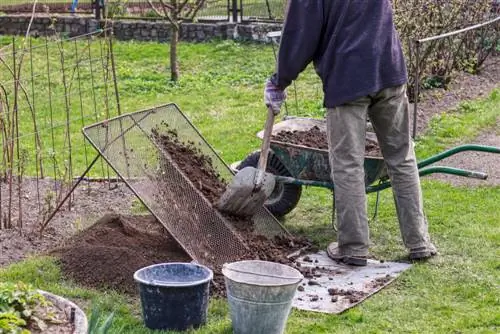
Sifting topsoil is easy with a sieve
- Throw-through sieve with support and mesh size of at least 10 cm, preferably 15 cm
- Spade
- Calculations
- Work gloves
- Wheelbarrow (for quantities of 1 cubic meter or more, ideally as a rented motor wheelbarrow)
- Garbage bags
Sifting topsoil - instructions for beginners
A standard sieve weighs around 4 kilograms. For a streamlined workflow, it is therefore advisable to set up the sieve where you want to distribute or fill up the sieved topsoil. Without much effort, you can move the sieve to where the soil substrate is needed. Here's how to proceed expertly step by step:
- shove the contaminated topsoil into a wheelbarrow and drive it to the sieve
- Throw the earth through the sieve, shovel by shovel
- fill waste collected in front of the sieve into the bags
- Remove the sieve when a large amount of clean topsoil has accumulated
- spread sifted topsoil with a rake
Sifted out components are usually not suitable for disposal in the compost. At best, root pieces from the bottom layer of the compost heap or raised bed can be used. Smaller natural stones (not rubble) act as drainage material in tree planting pits or under pavement slabs. For this reason, the materials list lists garbage bags in which you can collect unusable components and transport them to the nearest landfill.
How to dispose of topsoil in an exemplary manner
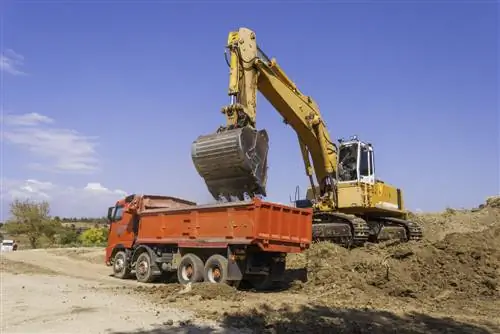
Large amounts of topsoil often have to be disposed of at great expense
In large quantities, topsoil does not always give the owner unadulterated joy. In fact, private builders or hobby gardeners are confronted with the question: What to do with excess topsoil? The legislature has a say in this, because careless disposal or even destruction of living natural assets is prohibited and is punished with high fines. The following options are available to dispose of topsoil legally and cheaply:
- Rent a truck with driver, shovel the topsoil onto the loading area and transport it away
- Sift the topsoil, drive with a car trailer to the horticultural business nearby and hand it over free of charge
- Publish excavated earth in the soil exchange and have it picked up by interested parties
- Disposal by a specialist company in a container
In contrast, all procedures that result in the destruction of topsoil are taboo. This includes mixing the valuable soil substrate with cement to produce concrete.
Excursus
Topsoil Humus Difference
Topsoil is not the same as humus. In fact, there is an important difference between the two soil substances. As the definition of experienced soil scientists tells us, topsoil is the upper, fertile horizon down to a depth of around 30 centimeters. Humus is the component in which life rages in the form of busy soil creatures, microorganisms and bacteria that take care of the construction and conversion of topsoil. At the same time, humus acts as a nitrogen source for topsoil and therefore represents the basis of life for soil organisms and plants at the same time. In addition, topsoil contains inorganic components such as sand, clay or sediments.
Laying paving slabs on topsoil - tips & tricks

Slabs can also be laid without cement
Slab paving is becoming increasingly popular as the ideal alternative to paved paths in the garden. Laid in step widths and at ground level, unkempt paths are a thing of the past thanks to decorative tread plates. There are further advantages in favor of the natural solution: no cement is required. Paving slabs do not represent an obstacle for lawnmowers and robotic lawnmowers. The existing topsoil serves as the base. This is how it works:
- Lay out pavement slabs along the route in increments
- Measuring distances (plate center to plate center)
- Mark plate positions with spade marks
- Put the footplates aside
- Cut out sod as deep as the slabs are high plus space for the substructure
- Press the topsoil with a hand tamper
- Spread sand (3-5 cm high)
- Place paving slabs on the sand bed and align them to the ground using a spirit level
Fill the remaining gaps between the tread plate and the adjacent surface with topsoil or garden soil. Slurry the laid paving slabs with water from the watering can to ensure a good seal to the ground.
Using topsoil for lawns - How does it work?
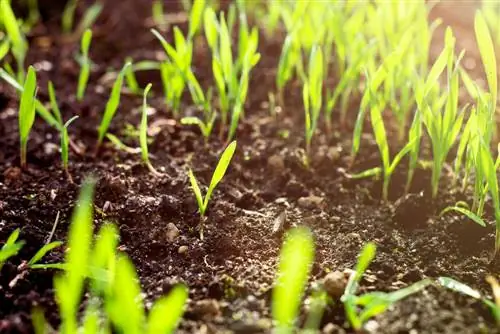
Lawn thrives best on fertile topsoil
The creation of new lawns becomes a successful project if the seedbed is on sifted topsoil. How much you add valuable topsoil depends on whether you only sow lawns or grow other plants in the middle of the green space, such as trees, shrubs or perennials. In practice, a minimum topsoil height of 30 centimeters has proven to be correct for mixed planting. A purely green area requires a 15 to 20 centimeter high base as fine subgrade. Distributing topsoil under lawns only covers part of the work. How to use topsoil correctly for lawns:
- Remove old turf manually or with a peeling machine
- loose up compacted ground with a rake or rotary tiller
- Dig up existing topsoil to the depth of a spade and sieve (see instructions above)
- enrich loamy-wet soil with 15 kg of sand per m²
- Improve dry, lean soil with sifted compost soil
Finally, you can use a ruler and calculator to determine how much additional topsoil you need to purchase. Ideally, spread fresh topsoil under the lawn on a previously laid mole net. The furry insectivores cannot resist the temptation of topsoil with juicy beetles and fat larvae.
Tip
If you know what you're doing, you can get topsoil for free or very cheaply. The Federal Soil Protection Act and the Building Code stipulate that excess topsoil must be preserved in a usable condition. Numerous land exchanges across the country are working to bring providers and interests together. You can read useful information at mutterboden.de. Here you will find contact details for all federal states and many cities, such as Berlin, Hamburg, Bremen, Düsseldorf, Cologne or Rostock.
Buy topsoil cheaply - ideas for bargain hunters
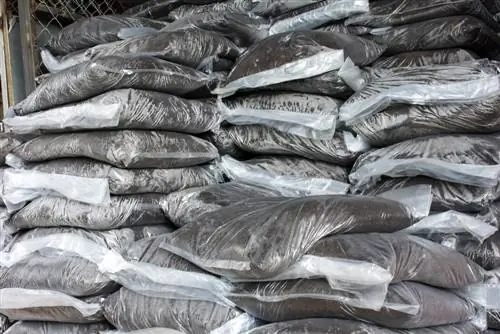
The bigger the bag, the cheaper the soil
Scouring soil exchanges or finding free sources of topsoil nearby takes time. Builders and hobby gardeners with busy schedules can order loose goods or bagged goods (big pack) and have them delivered to the property boundary. We looked around the market and compiled the following key data for an initial orientation about the costs:
- Building material suppliers: Big pack (500 kg) from 150 EUR/piece, bulk goods (3 t minimum quantity) from 280 EUR
- Container services: topsoil/topsoil from 11.50 EUR/t plus VAT and delivery costs
- Composting sites: topsoil sifted, enriched with sand and compost from 23 EUR/t as bulk material
- Civil engineering companies: Unscreened topsoil from 12 EUR/t as bulk material
- Gardening companies: Price on request from the provider nearby
Please note that the prices of building materials dealers, container services or other commercial providers of bulk goods are generally regionally limited. Furthermore, these suppliers only start their vehicles when they have a minimum purchase quantity. If this limit is not met, there are sometimes considerable surcharges for small quantities. Therefore, please ask carefully before ordering topsoil and having it delivered.
In the hardware store in Obi or Hornbach as well as in local garden centers, however, you will look in vain for topsoil in bags, as you are used to with conventional potting or planting soil.
Frequently asked questions
What is topsoil?
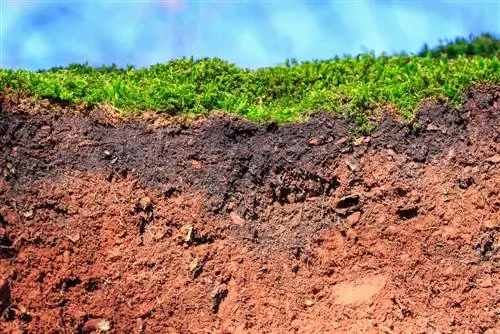
Topsoil is the top layer of the earth
According to the definition, topsoil is the uppermost, most fertile soil horizon. The valuable layer of earth is also known as topsoil or topsoil. Farmers talk about the topsoil. Topsoil is rich in nutrients, organic humus and densely populated with active soil organisms. It also contains mineral components such as sand, granular sediments and clay. In Central Europe, the valuable topsoil extends to a depth of 20 to 30 centimeters. Below, lean layers of earth begin with significantly fewer microorganisms and bacteria.
How much topsoil goes under the lawn so that the grass grows densely and evenly after sowing?
The noble grasses in the lawn usually have roots about 7 centimeters deep. In order for lawn seeds to turn into a lush green, dense carpet, the seedlings should be provided with a subsoil of topsoil at least 15 centimeters deep as a fine subsoil. Ideally, you spread the topsoil on a base of around 5 to 10 centimeters thick as a rough subgrade. A mix of filling sand, compost soil and clay-containing garden soil as drainage is well suited for this purpose.
We would like to create new lawn on a green patchwork carpet. Is it possible to spread topsoil on old lawns as a substrate for sowing grass seeds? How high should the soil layer be?
Removing an old lawn to create a new one is too laborious and time-consuming for many hobby gardeners. Thanks to the sandwich method, this is not even necessary. Mow the old green area as short as possible. Then use the scarifier to thoroughly comb out the weeds and moss. In the next step, spread a 15 centimeter high layer of sifted topsoil. This is the ideal surface for grass seeds or turf. Please note that the sandwich method only makes sense if the resulting height difference to neighboring areas is not a problem.
Is it allowed to mix topsoil with cement to make concrete?
Topsoil is a valuable natural asset that has been created over the course of many thousands of years. For this reason, the life-giving soil substance is subject to strict legal protection. According to the Federal Soil Protection Act, it is prohibited under pen alty of law to carry out harmful interventions in topsoil. At the top of the prohibited list is the addition of cement to produce concrete.
How much topsoil needs to be under turf?
Rolled turf is peeled off the field in long strips and already has some topsoil in its luggage. With the grass strips being 1.5 to 3 centimeters thick, the amount of valuable topsoil is of course limited. We therefore recommend that you use a 15 to 20 centimeter high layer of sifted topsoil as a base for rolled turf, which you spread on a rolled coarse subgrade made of garden and compost soil with filling sand.
Should topsoil always be screened?
No, because good quality topsoil is full of life and should not be thrown through a sieve. Sifting is only necessary if things have gotten into it that have no place in mother earth. This includes building rubble, thick roots or large stones. Building materials dealers and other commercial suppliers usually obtain topsoil from the excavation of properties, which makes it absolutely necessary to filter out unsuitable components.
What should you pay attention to when spreading topsoil on the property?
Good topsoil is characterized by a loose topsoil. This consistency should not be compromised when filling a property with topsoil. Please distribute the soil substrate manually using a spade, rake and rake. This does not mean that you should use a motorized wheelbarrow for larger quantities. With a weight of around 50 kilograms, the resulting compactions are within the acceptable tolerance limit.
Tip
Topsoil plays the main role when you create a vegetable patch. In order for potatoes, cabbage, lettuce and beans to thrive, the right substrate mixture is important. A mix of 60% topsoil, 30% compost and 10% sand or lava granules has proven to work well. Spread the previously sifted soil generously at 20 to 25 liters per square meter.

